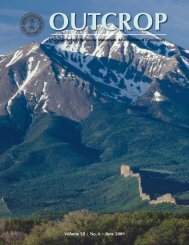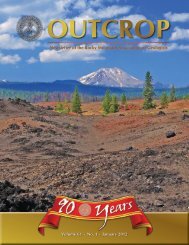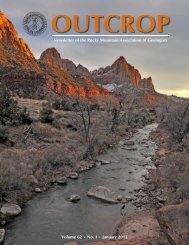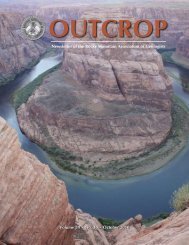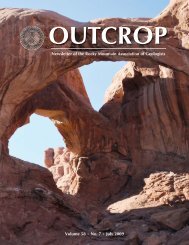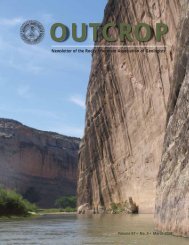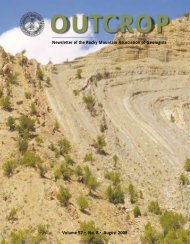May 2013 - Rocky Mountain Association of Geologists
May 2013 - Rocky Mountain Association of Geologists
May 2013 - Rocky Mountain Association of Geologists
- No tags were found...
Create successful ePaper yourself
Turn your PDF publications into a flip-book with our unique Google optimized e-Paper software.
Petroleum Systems Modeling —State <strong>of</strong> the Art and Future DirectionsBy Marek Kacewicz, AAPG Distinguished LecturerIn addition to its primaryfunction, which is to helpreduce exploration riskrelated to hydrocarboncharge, PSM has becomevery useful in prediction<strong>of</strong> pre-drill pressure andeffective stress, whichare utilized in reservoirand seal quality analysis.AAPG Distinguished Lecturer – <strong>May</strong> 1 st Continued on page 33 »Petroleum systems modeling (PSM) is an integration <strong>of</strong> different geologicaldisciplines to analyze the formation and evolution <strong>of</strong> sedimentary basins and tostudy processes such as generation, migration, entrapment and preservation<strong>of</strong> hydrocarbons. PSM estimates mechanical and chemical compaction <strong>of</strong>sediments and the resulting porosity/permeability, computes pressure, estimatessource rock maturity and the degree <strong>of</strong> kerogen transformation, models multicomponenthydrocarbon generation, expulsion and migration, provides likelylocations where hydrocarbons are trapped, and estimates composition andvolumes <strong>of</strong> accumulated hydrocarbons. In addition to its primary function,which is to help reduce exploration risk related to hydrocarbon charge, PSMhas become very useful in prediction <strong>of</strong> pre-drill pressure and effective stress,which are utilized in reservoir and seal quality analysis.Computational complexity <strong>of</strong> PSM depends on the quality and resolution <strong>of</strong>seismic and well input data, maturity <strong>of</strong> the project (exploration, developmentor production), availability <strong>of</strong> tectonic/structural/mechanical earth models, andavailability <strong>of</strong> geochemical data. Typical models at present are not too large(several millions grid cells) and the subsurface is represented by relativelysimple structured meshes. The utilization <strong>of</strong> structured meshes <strong>of</strong>ten resultsin inadequately represented internal model boundaries such as faults and maylead to incorrect hydrocarbon migration scenarios.Luncheon Reservations & InformationLuncheon will be held at the Marriott City Center at California and 17th St. Please check the event listing in thelobby for the room. Check-in/walk-in registration begins at 11:30 a.m., lunch is served at 12:00 noon, and thetalk begins at 12:20 p.m. The luncheon price is $30.00. To listen only to the talk, walk-in price is $10.00. Ifyou make a reservation and do not attend the luncheon, you will be billed for the luncheon. Online registrationcloses at 4:00 p.m. on the Thursday before the luncheon. Cancellations are not guaranteed after that time.Your attendance is welcomedand encouraged. Bring a guestor new member!Call 303-573-8621email staff@rmag.org,or register online.Vol. 62, No.530<strong>May</strong> <strong>2013</strong>




